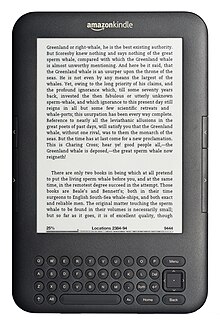E-reader

An e-book reader, also called an e-book device or e-reader, is a mobile electronic device that is designed primarily for the purpose of reading digital e-books and periodicals.
Any device that can display text on a screen may act as an e-book reader, but specialised e-book reader designs may optimise portability, readability (especially in sunlight), and battery life for this purpose. A single e-book reader is capable of holding the digital equivalent of hundreds of printed texts with no added bulk or measurable mass.[1]
Overview
An e-book reader is similar in form to a tablet computer. A tablet computer typically has a faster screen capable of higher refresh rates which makes it more suitable for interaction. Tablet computers also are more versatile, allowing one to consume multiple types of content, as well as create it.
The main advantages of e-book readers are better readability of their screens, especially in bright sunlight, and longer battery life.[2] This is achieved by using electronic paper technology to display content to readers. Commercially sold electronic paper is mostly available in black and white (16 shades of gray). The Sony Librie, released in 2004 and the precursor to the Sony Reader, was the first ebook using electronic paper. The first color e-book reader on the market was the Ectaco jetBook Color, with a 9.7" screen, though its muted colors have been criticized.[3]
Many e-book readers can use the internet through Wi-Fi and the built-in software sometimes provides a link to a digital OPDS Library or e-book seller, allowing the user to buy, borrow, and receive digital e-books free through this library or seller. In this way, the books owned by the user are managed in the cloud, and the e-book reader is able to download material from any location. An e-book reader may also download material from a computer or read it from a memory card.
Many of the major book retailers and third-party developers offer free (or premium or ad-paid) eReader applications for desktops, tablets and mobile devices, to allow the reading of eBooks and other documents independently of dedicated e-book devices.
Research released in March 2011 indicated that e-books and e-book readers are more popular with the older generation than the younger generation in the UK. The survey carried out by Silver Poll found that around 6% of over-55s owned an e-book reader compared with just 5% of 18 to 24-year-olds.[4] According to an IDC study from March 2011, sales for all e-book readers worldwide rose to 12.8 million in 2010; 48% of them were Amazon Kindles, followed by Barnes & Noble Nooks, Pandigital, Hanvon and Sony Readers (about 800,000 units for 2010).[5]
However 2012 saw a 26% decline in sales worldwide from a maximum of 23.2 million in 2011, although Kindle sales remain strong. The reason given for this "alarmingly precipitous decline" is the rise of more general purpose tablets that provide e-books along with other apps in a similar form factor.[6] In 2013, ABI Research claimed that the decline in the e-reader market was due to the aging of the customer base.[7]
Precursors
An idea similar to that of an e-reader is described in a 1930 manifesto written by Bob Brown titled "The Readies",[8] which describes "a simple reading machine which I can carry or move around, attach to any old electric light plug and read hundred-thousand-word novels in 10 minutes". His hypothetical machine would use a microfilm-style ribbon of miniaturised text which could be scrolled past a magnifying glass, and would allow the reader to adjust the type size. He envisioned that eventually words could be "recorded directly on the palpitating ether".[9]
Popular eBook readers
- Amazon: Kindle, Kindle Touch, Kindle Paperwhite
- Barnes & Noble: Nook, Nook Simple Touch, Nook Simple Touch GlowLight
- Bookeen: Cybook Opus, Cybook Orizon, Cybook Odyssey, Cybook Odyssey HD FrontLight
- Ectaco: JetBook
- Kobo: Kobo Touch, Kobo Glo, Kobo Mini, Kobo Aura, Kobo Aura HD
- Onyx: Onyx Boox M92, Onyx Boox i62ML
- PocketBook: PocketBook Pro 602, PocketBook Pro 902, PocketBook Pro 603, PocketBook Pro 903, PocketBook 360° Plus, PocketBook Basic 611, PocketBook 360° Plus New, PocketBook Pro 612, PocketBook Pro 912, PocketBook Touch, PocketBook Basic New, PocketBook Mini, PocketBook Touch lux, PocketBook Color Lux, PocketBook Basic Touch
- Sony Reader: PRS-T1, PRS-T2, PRS-T3
See also
- Comparison of e-book readers
- OPDS Open Publication Distribution System
- Supporting platforms for e-book formats
References
- ^ "Science", The New York Times, 2011-10-25.
- ^ Falcone, John P (August 7, 2012). "Kindle vs. Nook vs. iPad: Which e-book reader should you buy?". Crave. CNet. Retrieved January 26, 2013.
- ^ "Ectaco jetBook Color E-ink reader". Trusted Reviews. Retrieved June 17, 2013.
- ^ "E-book popularity set to increase this year". Retrieved 4 March 2011.
- ^ Nearly 18 Million Media Tablets Shipped in 2010 with Apple Capturing 83% Share; eReader Shipments Quadrupled to More Than 12 Million (press release), IDC, 10 March 2011.
- ^ "RIP e-book readers? Rise of tablets drives e-reader drop", News, C net.
- ^ "Tablets aren't killing e‐readers, it's clog-popping wrinklies – analyst", The Register, UK.
- ^ Brown, Robert ‘Bob’. The Readies (Books). Google. Retrieved 2012-12-06.
- ^ Schuessler, Jennifer (2010-04-08). "Bob Brown, Godfather of the E-Reader" (essay). The New York Times. Retrieved 2012-12-06.

